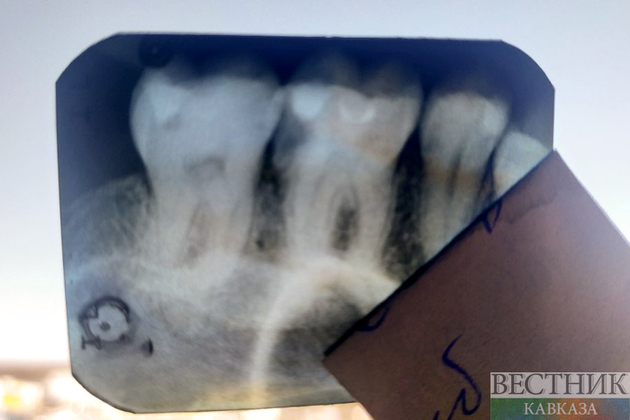Tombstones in what's now Kyrgyzstan have revealed tantalizing details about the origins of the Black Death, the world's most devastating plague outbreak that is estimated to have killed half of Europe's population in the space of seven years during the Middle Ages. CNN reports that the source of that pandemic has been debated by historians for centuries, but the inscribed tombstones -- some of which referred to a mysterious pestilence -- and genetic material from bodies exhumed from two grave sites that date back to the 13th century have provided some concrete answers to this long-standing question.
Researchers first excavated the burial sites in the 1880s. The tombstone inscriptions, written in the Syriac language, were painstakingly reexamined in 2017 by historian Phil Slavin, an associate professor at the University of Stirling in Scotland. He noticed that of the 467 burials that were precisely dated, a disproportionate number -- 118 -- were from just two years: 1338 and 1339. It's a revelation he described as "astonishing."
"When you have one or two years with excess mortality, it means that something was going on. But another thing that really caught my attention is the fact that it wasn't any year -- because it was just seven or eight years before the (plague) actually came to Europe," Slavin told a news briefing. "I've always been fascinated with the Black Death. And one of my dreams was to actually be able to solve this riddle of its origins," he added.
Slavin and his collaborators discovered the remains of 30 of the individuals buried in the Kyrgyzstan grave sites had been taken to the Peter the Great Museum of Anthropology and Ethnography in St. Petersburg, Russia. The research team was able to get permission to attempt to extract DNA from the skeletons to understand how they had died.
For seven of the individuals, the researchers were able to extract and sequence DNA from their teeth. In this genetic material, they found the DNA of the plague bacterium -- which scientists call Yersinia pestis -- in three of the individuals, who all had the death year 1338 inscribed on their tombstones.
This confirmed that the pestilence mentioned on the tombstones was indeed the plague, which is spread from rodents to humans via fleas.
In 1347, plague first entered the Mediterranean via trade ships transporting goods from territories around the Black Sea. The disease then spread across Europe, the Middle East and northern Africa, claiming up to 60% of the population, according to the study that published in the journal Nature on Wednesday.
Some historians believe the plague that caused the Black Death originated in China, while others think it emerged near the Caspian Sea. India has also been raised as a possible source. The plague strain continued to circulate around the world for 500 years.
Evolution of the plague strain
The latest study adds to a wealth of information revealed by sequencing ancient pathogens such as plague that leave a genetic imprint in human DNA. In 2011, scientists first sequenced the genome of the plague bacterium -- Yersina pestis -- found in two plague victims buried in a pit in London. Since then, more genetic material has been retrieved from grave sites throughout Europe and southern Russia.
This work showed an explosion in diversity of plague strains -- a big bang -- that occurred in the evolution of the plague bacterium sometime before the Black Death ravaged Europe -- most likely in the 10th and 14th centuries.
The researchers involved in this latest study believe the area surrounding the two cemeteries near Lake Issyk-Kul in Kyrgyzstan must have been the origin of the plague strain that caused the Black Death because two ancient plague genomes the team pieced together from the teeth revealed a single plague strain that's the most recent direct ancestor of this big bang event. This places it right at the very beginning of the Black Death outbreak and before it arrived in Europe.
"We found that the ancient strains from Kyrgyzstan are positioned exactly at the node of this massive diversification event," said lead study author Maria Spyrou, a postdoctoral researcher at the University of Tübingen in Germany.
Further evidence to back up the study researchers' claim came from comparing plague strains found in modern-day rodents with those they sequenced from the cemeteries. They found that the modern plague strains most closely related to the ancient strain are today found in wild rodents, such as marmots, living in the Tian Shan mountains, very close to the two grave sites.
"What's really remarkable is that today, in the rodents living in that region, we have the closest living relatives of that big bang strain (of plague bacteria)," said senior study author Johannes Krause, director at the Max Planck Institute for Evolutionary Anthropology in Leipzig, Germany.
"We found not just the ancestor of the Black Death, but we actually found the ancestor of the majority of plague strains that are circulating in the world today."
There is still much the team doesn't know, such as from exactly which animal the disease spilled over into humans. But understanding the origin of the biggest pandemic in human history could help prepare for future disease spillovers, Krause said.
"Just like Covid, the Black Death was an emerging disease, and the start of a huge pandemic that went on for some 500 years. It's very important to understand actually in what circumstances did it emerge," Krause said.






